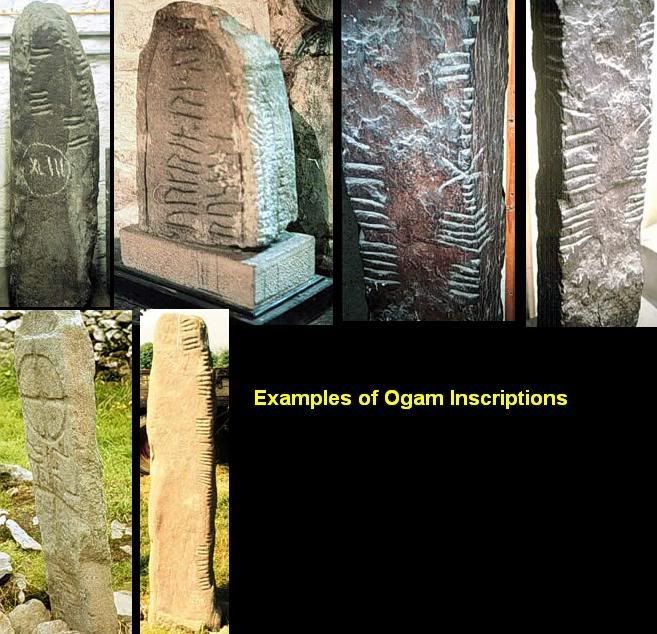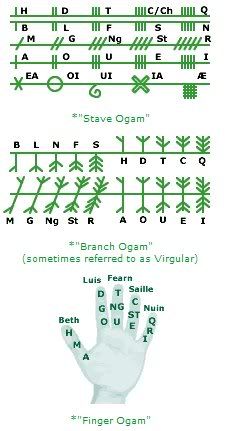Post by bluefedish on Feb 5, 2008 1:08:23 GMT -5
The Celts were the only people to use ogam (also "ogham"), using it as a form of secret communication, yet it was also used for divinatory purposes. Examples of Ogam can still be seen today, carved on stones scattered throughout the British Isles and the European mainland. Some of the stones are only named tages referring to great heroes in history or used to mark boundaries, but some are clearly of more mystical purpose. Ogam itself is a very complex language capable of many different subtle layers, some of which are lost to us, through its associations with trees different elements and colors one word could mean several things and in the hands of a true bard many political undercurrents could be construed that could crush the mightiest conquerer.
The Celts themselves were a fiery creative people, quick tempered and renowned as fearless warriors. This stemmed from their religious beliefs which the afterlife was an integral part of. This belief also had a proficient effect on their culture and most notably their art. The Celtic mythology and art made a profound impact an dinfluence through out Europe. Celts still survive to this day their descendants can now be found in Scotland, Ireland (which has always been the center of their world), Wales and parts of Brittany and Spain.
Divination
By using Ogam symbols is mentioned in Tochmarc Etaine, a tale in the Irish Mythological Cycle. In the story, druid Dalan takes 4 wands of yew, and writes Ogam letters upon them. Then he uses the tools for divination. The tale doesn't explain further how the sticks are handled or interpreted.
Some modern Druids, Neo-Pagans, and other interested people use Ogam as a divination system, in a manner reminiscent of the incomplete description in Tachmarc Etaine. They create a series of sticks, one for each letter. The sticks may be used in a fashion similar to runic divination. Another method requires a cloth marked out with Finn's Window. A person selects some sticks randomly, throws them on the cloth, and then looks both at the symbols and where they fell.
The divinatory meanings are usually based on the tree Ogam, rather than the kennings of the Briatharogam. Each letter is associated with a tree or other plant, and meanings are derived from them. Robert Graves' book "The White Goddess" has been a major influence on assigning divinatory meanings for Ogam. Some reconstructionsists of Druidic ways use Briatharogam kennings as a basis for divination meanings in Ogam divination. The 3 sets of kennings can be separeted into Past-Present-Future or Land-Sea-Sky groupings in such systems, but other organizing structures are used, as well.

Ogam Alphabet below

Selected Sources:
www.uponreflection.co.uk/ogham/history.htm
en.wikipedia.org/wiki/Ogham
The Celts themselves were a fiery creative people, quick tempered and renowned as fearless warriors. This stemmed from their religious beliefs which the afterlife was an integral part of. This belief also had a proficient effect on their culture and most notably their art. The Celtic mythology and art made a profound impact an dinfluence through out Europe. Celts still survive to this day their descendants can now be found in Scotland, Ireland (which has always been the center of their world), Wales and parts of Brittany and Spain.
Divination
By using Ogam symbols is mentioned in Tochmarc Etaine, a tale in the Irish Mythological Cycle. In the story, druid Dalan takes 4 wands of yew, and writes Ogam letters upon them. Then he uses the tools for divination. The tale doesn't explain further how the sticks are handled or interpreted.
Some modern Druids, Neo-Pagans, and other interested people use Ogam as a divination system, in a manner reminiscent of the incomplete description in Tachmarc Etaine. They create a series of sticks, one for each letter. The sticks may be used in a fashion similar to runic divination. Another method requires a cloth marked out with Finn's Window. A person selects some sticks randomly, throws them on the cloth, and then looks both at the symbols and where they fell.
The divinatory meanings are usually based on the tree Ogam, rather than the kennings of the Briatharogam. Each letter is associated with a tree or other plant, and meanings are derived from them. Robert Graves' book "The White Goddess" has been a major influence on assigning divinatory meanings for Ogam. Some reconstructionsists of Druidic ways use Briatharogam kennings as a basis for divination meanings in Ogam divination. The 3 sets of kennings can be separeted into Past-Present-Future or Land-Sea-Sky groupings in such systems, but other organizing structures are used, as well.

Ogam Alphabet below

Selected Sources:
www.uponreflection.co.uk/ogham/history.htm
en.wikipedia.org/wiki/Ogham



